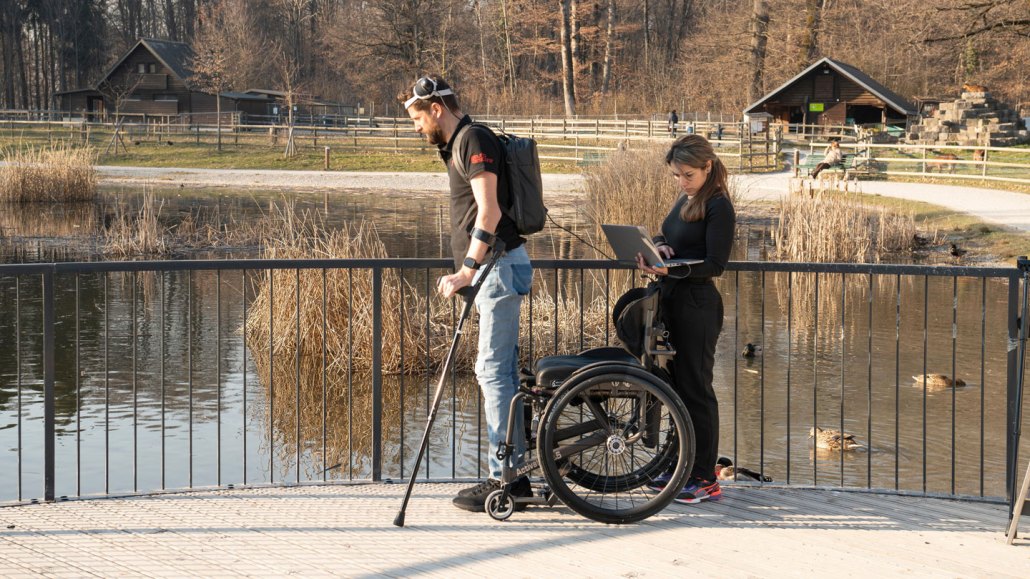A brain implant helped a man with paralysis walk more naturally
Restoring a communication link between the brain and spine enables more control over movement

A biking accident left 40-year-old Gert-Jan paralyzed by a spinal cord injury. Here, he and a researcher put a brain-spine interface that has restored some of his ability to walk through its paces.
Gilles Weber/CHUV
A system that restores communication between the brain and spine has enabled a man paralyzed by a spinal cord injury to regain near-natural walking ability.
Once the patient’s brain activity was decoded, the brain-spine interface took mere minutes to calibrate, after which the man reported natural-feeling control over movements. He still needs crutches but can easily navigate ramps and steps, surpassing gains from previous treatments, researchers report May 24 in Nature.
“The results are consistent with what I’d hope would happen, which is encouraging,” says V. Reggie Edgerton, a physiologist at Rancho Los Amigos National Rehabilitation Center in Downey, Calif., who was not involved in the study. Still, in terms of treating spinal cord paralysis, he says, “we’re at the stage of the Wright brothers and flight.”
Spinal cord injuries can interrupt communication between the brain and spine, causing paralysis. Previous research showed that stimulating spinal cord nerves can produce movement (SN: 8/3/22), but this is the first time that a patient’s own brain activity has been used to re-establish voluntary control of leg movements.
A biking accident 12 years ago left the 40-year-old man, who prefers to be identified by his first name, Gert-Jan, paralyzed with an incomplete spinal cord injury. Six years later, he enrolled in a clinical trial involving a spinal cord implant that stimulates nerves that control leg movements. He regained the ability to step with a walker, but this involved making unnatural heel movements, picked up by motion sensors, to trigger preprogrammed nerve stimulation patterns. He had difficulty starting and stopping, and could walk only over flat surfaces.
The new study aimed to hand control over to Gert-Jan’s brain. “Despite using the [spinal cord implant] stimulation for three years, he hit a plateau in his recovery, and became interested in using the new brain-controlled stimulation,” says Grégoire Courtine, a neuroscientist at the École Polytechnique Fédérale de Lausanne in Switzerland. “So he became our first test pilot.”
Courtine and colleagues added a brain implant to create a system that translates thought into movement. Two electrode arrays that sit on the surface of the brain record activity from the sensorimotor cortex, a region of the brain that helps direct muscle movements. These signals are sent wirelessly to a processing unit that converts them into stimulation patterns, which are transmitted to the spinal cord implant.
After implantation, Courtine and colleagues asked Gert-Jan to attempt leg joint movements while they analyzed his brain activity. Different patterns of activity differentiated hip, knee and ankle movements, the researchers found, enabling them to map brain signals to intended movements. The team created stimulation patterns targeting muscles that control putting weight down, pushing forward and leg swings, to reproduce walking motions. During use, an artificial intelligence algorithm translates incoming brain signals into appropriate command signals for the spinal implant.
The researchers calibrated the system so that Gert-Jan could control the amount of movement. “This brings a more fluid walking pattern,” Courtine says, helping him adapt his foot placement and even climb staircases.
“The stimulation before was controlling me, and now I’m controlling the stimulation,” Gert-Jan said May 23 during a news conference.
A “neurorehabilitation” training program while using the device led to mobility improvements even with the brain-spine interface turned off, the researchers found. “This suggests new nerve connections developed,” Courtine says.
Researchers need to understand more about how this recovery works. “The question is: Where in the brain is getting connected to where in the spinal cord? And we don’t really know that,” Edgerton says. “We need to figure out how the two are working together.”
The extent of Gert-Jan’s recovery delivered quality-of-life boosts, such as moving around the house independently, or standing at a bar drinking with friends. “That’s the goal of a lot of people who are completely paralyzed,” Edgerton says. “To be standing at a bar, looking people eye to eye.” While many paralyzed people prioritize other problems, such as bathroom function and blood pressure, this study aimed only to restore mobility.
Gert-Jan has been using the system for nearly two years now, Courtine says, and the brain implant has remained stable and reliable.
The researchers think the approach will work for other patients, but caution that the extent of recovery may depend on the severity of injury. “You have to be careful to calibrate expectations,” Courtine says. “But I’m confident we can reproduce the same outcome, especially in individuals with incomplete spinal cord injury.”
The team plans to apply the approach to the upper limbs too, neuroscientist Henri Lorach, also at the École Polytechnique Fédérale de Lausanne, said during the news conference. “We are initiating a clinical trial in three participants that will target these circuits.” It may also be possible to treat paralysis caused by stroke, the researchers say.
Courtine and colleagues developed a version of the system that Gert-Jan could operate himself at home, but further improvements are still needed. The processing unit is bulky, for example, and the brain implant involves two 5-centimeter-wide cylinders that sit in holes cut in the skull.
Onward Medical, a Lausanne-based company cofounded by Courtine, is working on miniaturizing the brain implant and processing unit, Courtine says, to develop a commercial version that “is easy for patients to use in daily life.”






